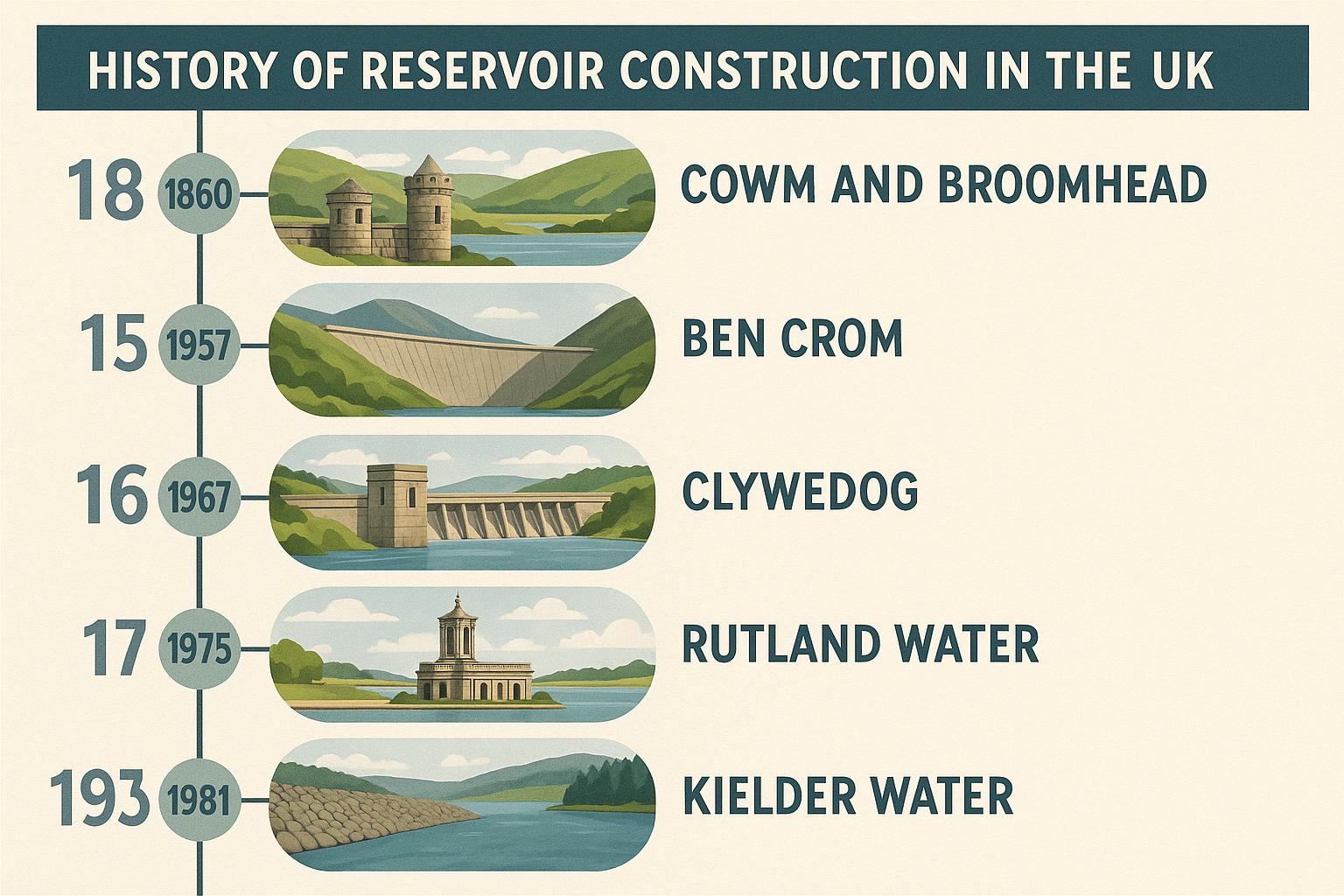The Early Beginnings of Reservoir Construction in the UK
The history of reservoir construction in the United Kingdom unfolds against the backdrop of urbanization and industrial growth, reflecting a vital response to the increasing demand for water. Reservoirs have been instrumental in ensuring consistent water supply through seasonal fluctuations and supporting diverse economic activities. This narrative explores the intricacies of reservoir development in the UK, from early beginnings to modern advancements, forming a crucial component of national infrastructure.
19th Century Developments
The onset of the Industrial Revolution in the late 18th century marked a pivotal increase in the need for dependable water sources. Rapid population growth in towns and cities demanded the enhancement of water infrastructure, leading to some of the earliest large-scale reservoir constructions in the UK during the 19th century. An iconic example of this era is the Thirlmere Reservoir, constructed in the Lake District in the 1890s, primarily to supply water to the burgeoning city of Manchester.
This period marked the beginning of significant infrastructure projects designed to cater to expanding urban areas. As cities like Manchester experienced population booms, the necessity for clean and reliable water supplies became evident. Engineers and planners saw reservoirs like Thirlmere as crucial not only for daily life but also for supporting the industrial sectors which were the backbone of economic expansion at the time.
Engineering Advances and Challenges
The late 19th and early 20th centuries were dominated by remarkable advancements in engineering, enabling intricate reservoir designs that expanded their capabilities. Building reservoirs in mountainous and remote locations posed significant challenges, yet these were met with innovative solutions such as the implementation of clay cores within earth-filled dams. This method improved the structural integrity of dams, ensuring their capability to contain vast volumes of water securely.
The harsh geographical and climatic conditions of places like the Lake District necessitated creative approaches. Engineers worked tirelessly to ensure that the reservoir constructions could withstand natural impediments, employing emerging engineering principles and continually refining techniques to optimize the balance between functionality and structural safety.
The Role of Legislation
Legislation played a fundamental role in reservoir development within the UK. The introduction of the Public Health Act of 1875 marked a pivotal point, granting local authorities the power to oversee sanitation and water supply initiatives. This empowerment facilitated the construction of essential infrastructure geared toward fostering healthier living conditions. Crucially, the Act encouraged municipalities to champion reservoir projects, creating a regulatory environment that supported long-term public welfare aims.
In addition to fostering direct benefits for public health, legislative frameworks also established guidelines for construction standards and maintenance practices, ensuring that reservoir systems could sustainably serve communities for generations.
20th Century Expansion
Throughout the 20th century, especially in the post-World War II era, there was an era of extensive reservoir construction. With urban areas expanding, cities required greater water supplies, which propelled efforts to construct larger reservoirs. The focus was on developing resilient infrastructure that could sustain industrial activity and burgeoning populations. Notable projects from this era include Kielder Water in Northumberland, completed in 1981. Renowned for being the largest man-made lake in Northern Europe at the time, Kielder Water exemplifies the ambitious engineering endeavors of the time aiming to support the nation’s growing demands.
This era emphasized the importance of strategic planning and resource allocation, promoting geographically dispersed water reserves capable of meeting the diverse needs of urban, suburban, and rural areas alike.
Environmental Considerations
Increased environmental awareness during the latter half of the 20th century initiated a shift in reservoir construction practices, incorporating ecological impact considerations. Projects began to undergo rigorous assessment of their effects on local wildlife and ecosystems. Engineers and planners adopted improved methodologies that balanced human necessities with environmental conservation, adopting design innovations to minimize adverse effects on biodiversity.
Focused efforts were made to preserve surrounding habitats during and after construction, ensuring that reservoirs contributed positively to regional ecological landscapes. Initiatives like environmental impact assessments gained prominence, promoting sustainability in every phase of infrastructure planning and execution.
Modern Trends and Future Prospects
Contemporary reservoir construction and management strategies continue to emphasize sustainability and technological integration. Modern reservoirs frequently incorporate features that support adjacent habitats and biodiversity. Community involvement in planning processes also gained traction, ensuring that projects align with local needs and expectations. Anticipated developments will focus on leveraging renewable energy solutions and advanced engineering techniques, tackling the challenges posed by climate change.
This forward-thinking approach emphasizes adaptability and resilience, ensuring that reservoirs can efficiently address societal demands amidst shifting environmental and climatic patterns. Future advancements aim to harmonize technological prowess with ecological stewardship, cementing the role of reservoirs within sustainable development goals.
In conclusion, the history of reservoir construction in the UK mirrors broader patterns of industrial and demographic progress, consistently evolving to meet societal needs. Continuous adaptation in response to technological, legislative, and environmental developments showcases a narrative of resilience and innovation. For further exploration of the socio-economic impacts of reservoir construction, the works of Beveridge, William and White, Helen provide valuable insights.
